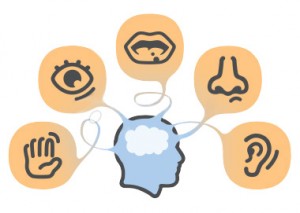
Sensory Processing , formerly referred to as “Sensory Integration”, is a term referring to the way that the nervous system receives messages from the senses and turns them into appropriate motor and behavioral responses. Whether you are eating waffles, riding a scooter, or reading a book, your successful completion of any activity requires processing many different sensations.
A Sensory Processing Disorder (SPD) exists when sensory signals cannot organize themselves into appropriate responses. A child with SPD finds it difficult to process and act upon information received through the senses which, in turn can create severe challenges in performing a multitude of everyday tasks. Behavioral and social interaction problems, having trouble learning new skills, anxiety in unfamiliar settings, and school difficulties are a few ways that SPD can affect a child that does not receive effective treatment.
Sensory Processing Disorder can affect a child in one sense – just touch, sight, or movement – or in multiple senses. One child with SPD may over-respond to the touch sensation and find certain clothing or physical contact unbearable. Another might under-respond in reaction to stimulation – even pain or extreme hot and cold. Other children might perpetually seek out certain sensations. Children receiving impaired messages from their muscles and joints might experience poor posture and motor skills and, as a result, may have low self-esteem, and struggle academically.
People unaware of this disorder, including parents and educators, may label children with SPD as clumsy, uncooperative, disruptive, or “out of control.” Without an appropriate diagnosis and therapy, anxiety, depression, aggression, or other behavioral and social problems can follow.
Children with SPD can benefit from a treatment program of occupational therapy (OT). Treatment typically takes place in a sensory-rich environment sometimes called an “OT gym.” During OT sessions, the therapist guides the child through fun activities that are very subtle, but challenging. The goal of OT is to foster appropriate responses to sensations in an active, meaningful, and fun way so the child is able to gain functional skills. Over time, the appropriate responses generalize to the environment beyond the clinic to include school, home, and the larger community. Effective treatment enables children with SPD to take part in the normal activities of childhood, such as playing with friends, enjoying school, eating, and dressing.
If you have questions about OT services, please call our office at (503) 352-0240 and ask to talk to one of our occupational therapists.

Inoue M, Tajima K, Hirose K, et al buy generic cialis Burkiewicz JS, Scarpace SL, Bruce SP Denosumab in osteoporosis and oncology
Thanks for sharing. I read many of your blog posts, cool, your blog is very good.
The point of view of your article has taught me a lot, and I already know how to improve the paper on gate.oi, thank you. https://www.gate.io/tr/signup/XwNAU
Apoiar ferramentas de apostas e estar equipado com uma plataforma diversificada de transações financeiras, a 20Bet oferece suporte tangível aos jogadores. Este é um lugar onde eles podem apostar com dinheiro real, respaldados por concorrentes de diversas disciplinas esportivas. 20bet
Thanks for sharing. I read many of your blog posts, cool, your blog is very good. https://www.binance.com/ph/register?ref=RQUR4BEO